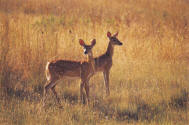DEER
|
|
Habakkuk 3:19 Sovereign YAHWEH is my strength; He makes my feet like the feet of a deer, He enables me to go on the heights. |
Although there are several species of deer, we are going to concentrate on the more common "white-tailed" deer which is found throughout most of the United States as well as other continents. As with most animals, the white-tailed deer has a longer name which is Odocoileus virginianus, because the underside of its tail is covered with white hair. Most of you reading this have probably seen a white-tailed deer run away. Its tail goes straight up and many times all you see is its white tail as it is leaving!
Before we get into specific information about the white-tailed deer, it should be mentioned that there are many animals you may have heard of which are members of the same family as the deer. These would include the moose, the elk, the caribou and the mule deer.
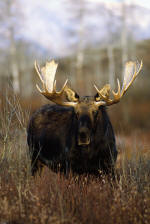 |
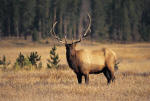 |
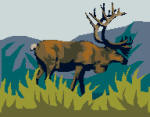 |
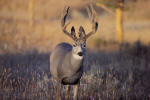 |
| MOOSE | ELK | CARIBOU | MULE DEER |
You have probably heard your friends and/or family talk about clean and unclean animals for food. There are criteria which Yahweh gave us to determine what is fit for us to eat. Deer, and all the members of the deer family are good for us because they have a split-hoof and they chew the cud. The white-tailed deer is a ruminant, which is any of various hoofed, even-toed, usually horned mammals which characteristically have a stomach divided into four compartments. "Chewing the cud" merely means they chew their food once, bring it up and chew it again. There are many animals that do this.
Deer eat many kinds of food including corn, fruit, acorns, plants and they think nothing of coming up into your yard to eat those beautiful flowers that Mom and Dad planted!
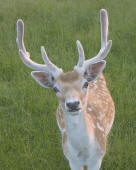 The male deer generally have "antlers" which start to grow in the spring, normally March/April. The new "antlers" are said to be in "velvet" because that is what they look like. The picture to the right shows what the antlers look like in velvet. There are actually blood vessels contained in the velvet to feed the antlers as they grow. In the fall, the males (commonly called "bucks") will "rub" their antlers against things, especially smaller trees, to wear off the velvet. If you take a walk in an area where you know the deer roam, look for "rubs" on younger trees in the fall. The bucks keep the antlers during the breeding season (that's when the female deer can get pregnant) and then they lose their antlers, only to have them grow back again next spring.
The male deer generally have "antlers" which start to grow in the spring, normally March/April. The new "antlers" are said to be in "velvet" because that is what they look like. The picture to the right shows what the antlers look like in velvet. There are actually blood vessels contained in the velvet to feed the antlers as they grow. In the fall, the males (commonly called "bucks") will "rub" their antlers against things, especially smaller trees, to wear off the velvet. If you take a walk in an area where you know the deer roam, look for "rubs" on younger trees in the fall. The bucks keep the antlers during the breeding season (that's when the female deer can get pregnant) and then they lose their antlers, only to have them grow back again next spring.
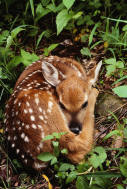 Female deer (commonly called "doe") will generally have their young in May or June and, although triplets are not uncommon, twins or a single baby is more common. A baby deer is called a "fawn" and is born with white spots to help camouflage it in the wild. You can see a newborn deer to the left. Aren't they cute? They look so cuddly, too!
Female deer (commonly called "doe") will generally have their young in May or June and, although triplets are not uncommon, twins or a single baby is more common. A baby deer is called a "fawn" and is born with white spots to help camouflage it in the wild. You can see a newborn deer to the left. Aren't they cute? They look so cuddly, too!
The new fawns stay with Mom throughout the summer. When they are a year-old ("yearlings"), they leave the family in the summer. In September or October the yearlings generally will return to Mom and the new babies.
Deer can be very easy to track because of their distinctive hoof prints. The next time you are in an area where you know deer have been spotted, check the ground carefully for traces of them. By the chart to the left, you can get an idea of how old the deer is that you see. You can sometimes see a doe with a fawn walking either in line or close to each other. You can also at times see other animal tracks, perhaps a dog, which was chasing the deer.
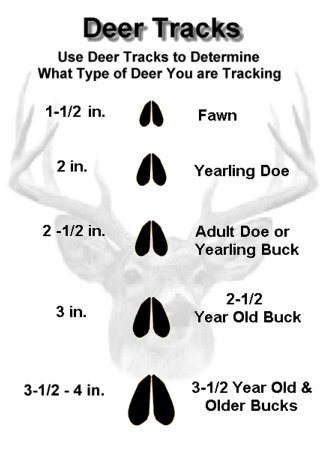
You will note from the chart that the older, or larger, the deer, the larger the print. This makes it easier also to determine what exactly passed through the area you are in.
We mentioned earlier about how deer and members of the deer family are clean animals to eat. It should be noted that deer is one of the most common animals hunted, both for food and for their antlers. The meat from a deer is commonly referred to as "venison" and is one of the best types of red meat you can eat because of being very lean. There are many, many recipes for venison and, should you have the opportunity, you should at least try it.
We know that just like all the other animals we have looked at so far and will continue to look at, the deer was part of Yahweh's divine plan. I am glad that Yahweh made them just the way He did!


